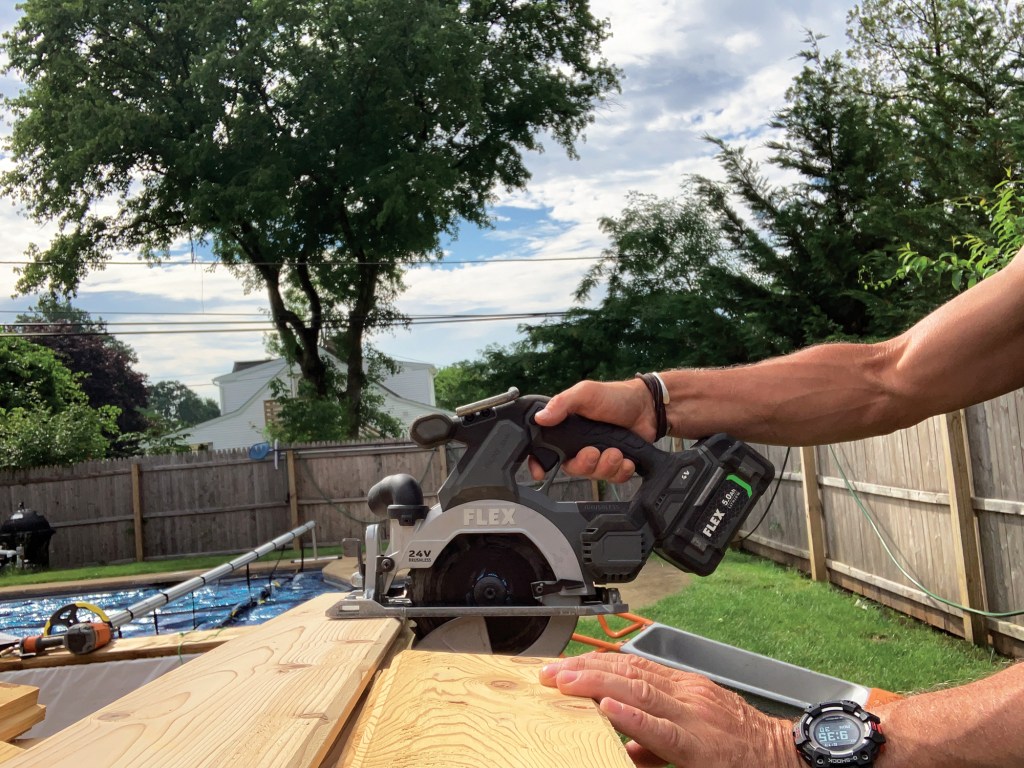
When I was editor of Tools of the Trade, I had a conversation with a tool designer who told me, “We’re innovating in a very small space.” What he meant, I believe, is that when it comes to circular saws, there’s not a lot to add to them that they don’t already have. A case in point is the Flex 24-volt 6 1/2-inch in-line cordless circular saw, which is innovative while at the same time being influenced by other tools, some long and sadly off the market.
The saw is a bit of an oddball. It’s a sort of top-handle, sort of in-line, awkward/not awkward belt-drive battery-powered circular saw with a downsized 6 1/2-inch blade. Even so, it has become my everyday carry to the point that I feel awkward using anything else.
My primary focus is as a work-alone carpenter building decks and doing general remodeling activities. I cut enough pressure treated lumber that my blade teeth turn green. I’m primarily making square cuts, so I don’t need a tool that will cut deep bevels. But I do need a meat-eater that’ll cut my peculiar beam ends and rip soaking-wet 2-by PT stock—and not break my arm off while doing it.
Blade size and power. Even with a 6 1/2-inch-diameter blade, this saw cuts 99% of everything I need to cut: PT stair stringers, end cuts for joists and deck boards, gang cuts in composite deck boards off the stack (trimmed later with a track saw), long cuts trimming V-joint tongue-and-groove roof deckers or deck boards to length after installation. In fact, it cuts 99% of what I need cut with the base of the saw raised a little off the stock, which makes the blade guard roll easier. The saw is powered by a brushless motor that spins at 5,500 rpm. The included blade is excellent.
In use, the Flex saw reminds me of a couple of saws in the 5-inch range, including Porter-Cable’s beloved 314 wormdrive 4 1/2-inch trim saw (no longer in production), and Ridgid’s compact Fuego 6 1/2-inch sidewinder. While it is similar in some ways, it is also a lot different. For example, it has a belt drive that offers a plush start and quiet operation with about zero reaction torque.
In-line, blade-left. During my time at JLC Live as a presenter, I discovered that I was cutting like a West Coast wormdrive user but giving myself scoliosis doing it because—as an East Coaster—I was using a sidewinder saw. Learning to cut with one of the wormdrive saws issued by the show staff was a watershed moment for me. With its blade-left design, the Flex saw offers many of the attributes of wormdrive cutting, minus the worm gear, 10 pounds of weight (the saw weighs 7.1 pounds without the battery), the power cord, and wrist twist on every cut.
Lines of sight to the blade are magnificent. The stout aluminum shoe is clearly stamped with the blade kerf and location; so well, in fact, that I actually use the shoe sometimes. Its thickness rides along my square (I use the square as a guide; such a labor saver and the cut is dead-on). Though I’m not gentle with the tool after the cut and let it hit the ground, it comes back square.

The saw has a blade-left design, a rafter hook, and an adjustable dust port that can be hooked up to a vacuum or swiveled to eject dust away from your cut line.
Top-ish handle and dust chute. This confluence of design features is where this saw really starts to overlap—and I don’t know if this is intentional by Flex—with tools of yore.
This tool is so top-heavy—tall, really—you can’t put it down like a sidewinder or worm drive. You have to lay it down (it takes a hot sec to change the neural pathways, but it works).
This is reminiscent of the old DeWalt worm drive that won many Tools of the Trade tool tests back when I was editor. It has a similar angle of attack to the work, and it offers an angular reach that is extremely comfortable in many different scenarios.
The dust chute is a thing of beauty. I believe its intended use is a vac hook-up. Since I’m usually more worried about tornadoes or snow on my sites, my main concern for dust is keeping it off the work. Much like the legendary Porter-Cable “chimney,” the Flex ejects dust from an elbow at about 1 o’clock on the blade. It works fabulously well. What’s better is that it swivels. Wind in your face? Swivel the chute. Cutting stringers and dust is getting poured on the next cut line? Swivel. Dust covering a chalk line? Again, swivel. It’s awesome.
The standard kit costs $250 and comes with a massive 24-volt 5.0 amp-hour battery, which is both absurdly gigantic and fantastic. It seems to last forever, but even more, it serves as a secondary “handle” to pressure the saw through the cut. The saw has a rafter hook, which is handy for framing or working at sawhorses, and a built-in LED work light. The kit also includes a charger and tote bag. flexpowertools.com
Photo by Mark Clement.
